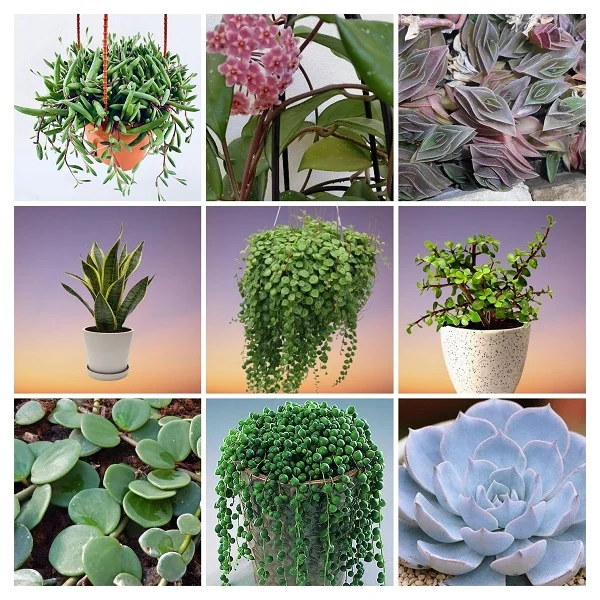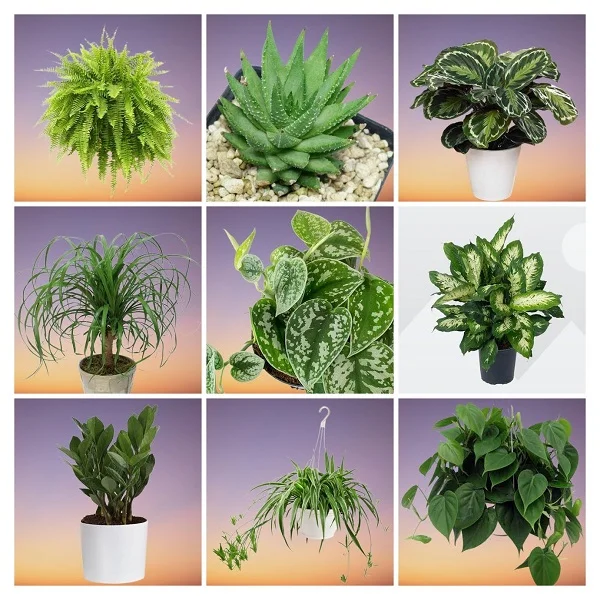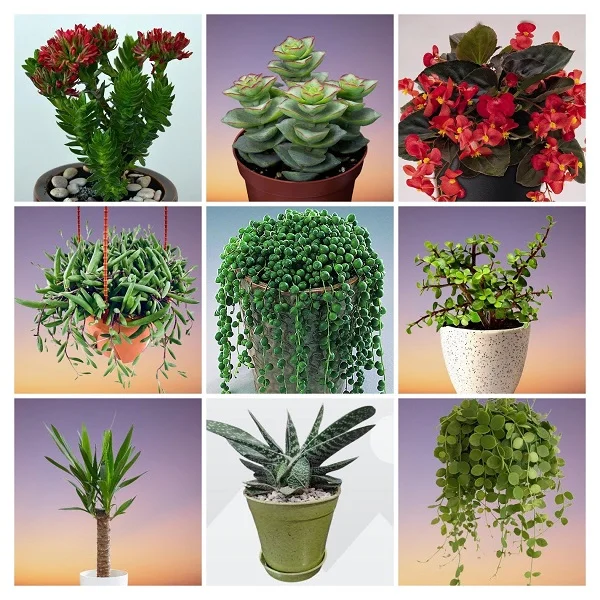Echeveria harmsii (Plush Plant) Care Indoors, Propagation, Problems & Remedies
Some links in this post may be affiliate links
Plush Plant (Echeveria harmsii) thrives in bright light with some sunlight, average warmth and humidity, and moderately moist, rich, well-drained soil coupled with fortnightly feeding in the growing season.
Echeveria harmsii also called Red Echeveria, Ruby Slippers Plant or Red Devotion Plant is one of the popular Echeveria varieties and forms a rosette of dark-green leaves with reddish edges which are covered in silver velvet.
Red Echeveria can be grown for both its beautiful foliage as well as its spectacular flowers. The flower is large, urn shaped, bright-orange with golden throats.
Echeveria Ruby Slippers is a small succulent plant which grows to a height of 2 feet. The rosette of leaves is oval-shaped and can reach about 3 inches long.
Red Devotion Plant leaves are thick and are more or less triangular in shape. The leaf color ranges from green to blue-green depending on the light exposure.
In Red Echeveria numerous offsets (pups) are produced at the base of the plant and can be used to propagate new plants.
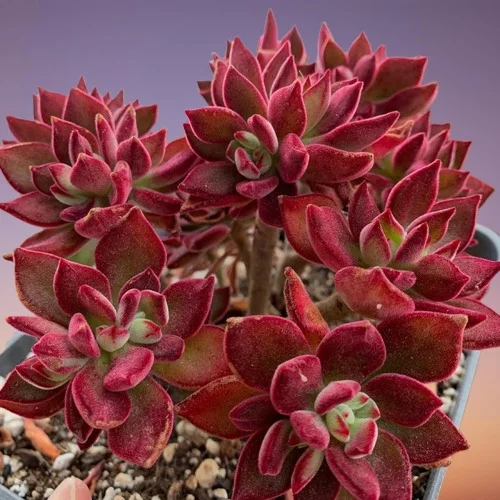
Botanical name: Echeveria harmsii
Family: Crassulaceae
Subfamily: Sempervivoideae
Common names: Plush Plant, Red Echeveria, Ruby Slippers Plant, Red Devotion Plant
Origin
Echeveria harmsii is native to Mexico and Central America where it can be found growing in the deciduous forest as well as on rocky slopes.
Echeveria Varieties
Many gorgeous hybrids of Echeveria have been developed and there is a wide selection to choose from. Some common varieties include Echeveria derenbergii (Painted Lady Echeveria), Echeveria desmetiana (Peacock Echeveria), Echeveria amoena and Echeveria carnicolor among many others.
Is Echeveria harmsii toxic?
No. Echeveria harmsii like other Echeveria are non-toxic to humans and pets as indicated by ASPCA. They are safe to grow in a home with children, cats, dogs and other pets.
Where to Buy
If you would like to add Echeveria harmsii to your collection, you may obtain them online from Etsy (Link to Etsy).
How to Care for Echeveria harmsii Indoors
To care for Echeveria harmsii indoors, give it bright light with 4-6 hours of direct sunlight, warmth of 16-280C, humidity of 50-55% and moderately moist, fertile, well-drained soil coupled with fortnightly feeding in spring and summer.
Echeveria Ruby Slippers does not require regular repotting as it has a small root system, therefore, repot it only when pot-bound. Pruning is necessary to keep the plant neat as well as minimize pest and disease infestations. Keep reading for more on these growing conditions and how to provide them.
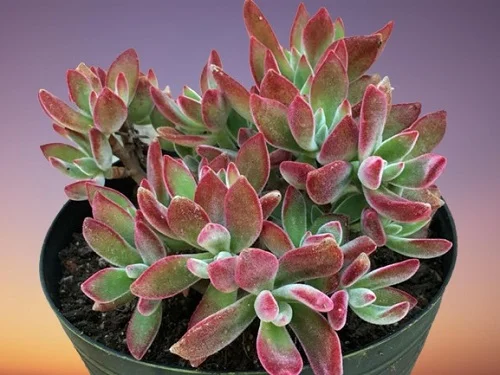
Watering
How often should I water Echeveria harmsii?
Water your Echeveria harmsii thoroughly in spring and summer while allowing the top 2-3 inches of soil to dry out between waterings. Keep the soil moderately moist and avoid sogginess to prevent rotting, yellowing and leaf drop.
Decrease watering in fall and winter to maintain the soil barely moist as growth is minimal at this time. Never allow the soil to dry out completely for a prolonged period to avoid wilting, drooping, yellowing and leaf loss.
Only use water that is at room temperature to avoid shocking the plant as it can result in reduced growth and leaf fall. Use chlorine-free water to prevent browning of leaf tips and edges.
Avoid wetting the center of the rosette as it can lead to rotting; water from the bottom instead. Ascertain that the pot has a drainage hole and the soil is fast-draining to prevent waterlogging as it can lead to rotting and death of the plant.
Light Requirements
Does Echeveria harmsii need direct sunlight?
Yes. Echeveria harmsii needs bright light with 4-6 hours of direct sunlight. Avoid exposing it to too hot sunlight before acclimating it as it can get sun scorched.
Too little light will result in leggy growth, yellowing and leaf fall. If the natural lighting is not adequate, you may use full spectrum grow lights to boost it.
Keep rotating the pot at intervals to ensure that the plant receives light on all sides for uniform growth to prevent lopsided growth.
Temperature & Humidity
What temperature is good for Echeveria harmsii?
Echeveria harmsii prefers a warmth of 16-280C during the growing season. Protect it from drafts to avoid temperature flactuations which can lead to stunted growth, yellowing and leaf loss.
Plush Plant flourishes in a humidity of 50-55%; it has no need for extra humidity. Ensure that there is good air circulation to prevent fungal diseases.
Fertilizer
Feed your Echeveria Ruby Slippers with a balanced, water-soluble fertilizer every 2 weeks in spring and summer to promote a lush growth. Stop feeding in fall and winter to prevent fertilizer burn as growth is reduced at this time.
Once in a while, leach out excess salts by running a stream of water through the soil until it comes out through the drainage hole. Let it run for 5-10 minutes to get rid of as much salt as possible.
Potting Soil
The best soil for Echeveria harmsii should be rich in organic matter, loose and free-draining to avoid getting soggy soil. The soil should be loose enough to allow water to drain out fast enough. Most Cactus and succulents mixes are great for these plants.
Repotting
Echeveria Ruby Slippers has a small root system so frequent repotting is not necessary. Repot it at the beginning of the growing season (spring to early summer), only when it becomes crowded in its current pot.
Use a pot 1 size larger and one that has a drainage hole to prevent the soil from getting soggy as it can lead to rotting. Select a shallow pot and be careful not to bury the stems to prevent rotting. Take a look at these succulents pots on Amazon.
Pruning
Pruning Echeveria harmsii involves removal dead or diseased leaves as they act as a breeding ground for pests and diseases.
If the plant is straggly with a nice rosette sitting on top of a long woody stem; cut off the rosette, allow it to dry (callus) in dry potting soil and it will root and grow into a new plant.
The woody stem can also be used for propagation where plantlets will form at the top of the stem. These plantlets can then be seperated from the stem when about 4-6 leaves have formed and grown in their own pots.
Echeveria harmsii Propagation
Echeveria harmsii is propagated from offsets (pups) which form at the base of the plant or from leaf cuttings. Propgate at the beginning of the growing season (spring to early summer) when the plant in in active growth for faster establishment.
1. How to propagate Echeveria harmsii from offsets
- Carefully seperate the offset from the mother plant. Use only an offset which has several leaves for faster establishment.
- Allow the offset to dry (callus) for 1-3 days before potting to prevent rotting.
- Pot the offset in its individual pot in moist, fast-draining soil and ensure that each pot has a drainage hole to avoid rotting.
- Position the pots in a well-lit spot away from direct sunlight to prevent scorching.
- Water the offset sparingly, only when the soil is dry and avoid soggy soil as it can lead to rotting.
- Allow the plant to be well established after which you can begin routine care.
2. How to propagate Echeveria harmsii from leaf cuttings
The leaf cuttings root easily and have no need for a rooting hormone.
- Take leaf cuttings from a healthy plant while ensuring that you are using the complete leaf as leaves whose base is broken may not root.
- Allow the leaf cuttings to dry (callus) for 1-3 days to promote rooting and prevent rotting.
- Lay the leaves on moist soil and do not allow the cut end to touch the soil.
- Place the set up in a warm, well-lit place and maintain the soil moist by light misting.
- Roots should grow into the moist soil and soon after, new plants will develop from the base of the leaf cutting.
- Carefully lift the new plants and pot in individual pots while taking care not to damage the delicate roots.
- Maintain the soil slightly moist until the new plants are well established after which you can begin routine care.
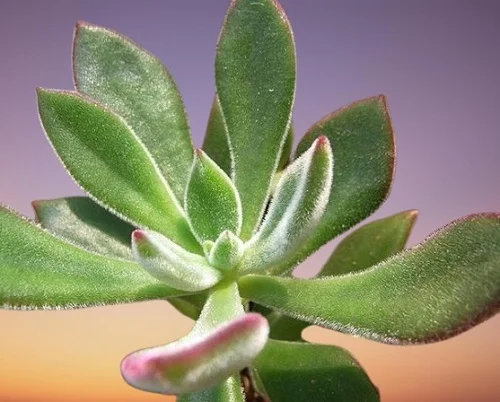
Echeveria harmsii Problems and Fixes
Echeveria harmsii (Echeveria Ruby Slippers) problems are yellow leaves, leaf loss, wilting & drooping leaves, leggy growth, pests and diseases among others. Keep reading for more on these problems and how to fix them.
Yellow leaves
Why is my Echeveria harmsii turning yellow?
The main causes of yellow leaves on your Echeveria harmsii are insufficient light, soggy soil, inconsistent watering, drafts, nutrients deficiency or aging.
How to fix it
Insufficient light: Position the plant in bright light with 4-6 hours of sunlight or use a grow light if you do not have enough light in your home.
Soggy soil: Use a fast-draining soil and a pot with a drainage hole.
Inconsistent watering: Water when the top 2-3 inches of soil feel dry but do not allow the soil to dry out completely. Do not water on schedule.
Drafts: Keep the plant away from drafts like hot air vents, AC units, hot surfaces, windy doors among others.
Nutrients deficiency: Feed the plant with a balanced, water-soluble fertilizer every 2 weeks in spring and summer.
Aging: This is a natural process. As the plant matures the lower leaves turn yellow and drop off.
Leaf loss
Why are my Echeveria harmsii leaves falling off?
Your Echeveria harmsii leaves are falling off due to inconsistent watering, soggy soil, too little light, cold drafts or use of cold water.
How to fix it
Inconsistent watering: Water when the top 2-3 inches of soil dry out but never allow the soil ball to dry out completely.
Soggy soil: Use a pot with a drainage hole and fast-draining soil.
Too little light: Position the plant in bright light with 4-6 hours of sunlight or use a grow light if you do not have sufficient light in your home.
Cold drfats: Keep the plant away from sources of cold drafts like windy doors, drafty windows, AC units among others.
Use of cold water: Use water that is at room temperature to avoid cold shock.
Wilting & drooping leaves
Wilting and drooping leaves on Echeveria Ruby Slippers are caused by inconsistent watering, soggy soil, temperature stress or salts buildup.
How to fix it
Inconsistent watering: Do not water on a schedule. Water when the top 2-3 inches of soil dry out and never allow the soil to dry out completely.
Soggy soil: Ensure that the pot has a drainage hole and the soil drains easily.
Temperature stress: Keep the plant away from sources of drafts like AC units, hot air vents, hot surfaces, windy doors among others.
Salts buildup: Regularly flush out excess salts by running water through the soil until it comes out through the drainage hole. Let it run for 5-10 minutes to get rid of most of the salts.
Leggy growth
Leggy growth (elongated stems and misshappen) on Echeveria harmsii is caused by too little light or overwatering.
How to fix it
Too little light: Move the plant to a brighter spot where it will receive bright light with 4-6 hours of direct sunlight or instal a grow light if the natural lighting is not adequate.
Overwatering: Do not water on a schedule; water only when the top 2-3 inches of soil dry out.
Pests
Common pests on Plush Plant are mealybugs, scales and spider mites which are prevalent in dry, stuffy conditions.
How to fix it
- Isolate the affected plant to prevent spread to other plants.
- Treat the infested plant with neem oil or insecticidal soap as instructed by the manufacturers.
- Regularly check underneath and between the leaves for these pests and carry out timely control measures.
- Maintain a good air flow to discourage the pests infestations.
Diseases
Echeveria harmsii is prone to powdery mildew, leaf spot disease and basal stem-rot disease:
1. Powdery mildew which is prevalent in overwet conditions.
How to fix it
- Isolate the affected plant to prevent spread to other plants.
- Spray the affected plant with neem oil as recommended by the manufacturer.
- Take care not to wet the leaves or water from the bottom instead.
- Maintain good air circulation to discourage the disease infestation.
2. Leaf spot disease which is enhanced by overwet conditions coupled with poor air circulation. It is characterized by brown, soft leaf spots.
How to fix it
- Isolate the affected plant to prevent spread to other plants.
- Spray the affected plant with a systemic fungicide and ensure to follow the manufacturer's instructions.
- Avoid wetting the center of the rosette during watering; you may water from the bottom.
- Improve ventilation to ensure good air circulation for the plant.
3. Basal stem-rot disease which is brought about by overwet conditions. The disease is characterized by a rotting plant base and stems collapse.
How to fix it
- At this point, the plant is too far gone and cannot be saved.
- Use the upper stem to propagate new plants and discard the infected parts.
Pests
Common pests on Echeveria desmetiana are mealybugs, scales and spidermites which are prevalent in dry, stuffy conditions.
How to fix it
- Isolate the affected plant to prevent spread to other plants.
- Treat the infested plant with neem oil or insecticidal soap as recommended by the manufacturers.
- Regularly check underneath and between the leaves for these pests and carry out timely control measures.
- Maintain a good air flow to discourage the pests infestations.
You liked it? Share on social media.
Related Content
Amazon Associates Disclosure
Homeplantsguide.com is a participant in the Amazon Services LLC Associates Program, an affiliate advertising program designed to provide a means for sites to earn advertising fees by advertising and linking to amazon.com.



